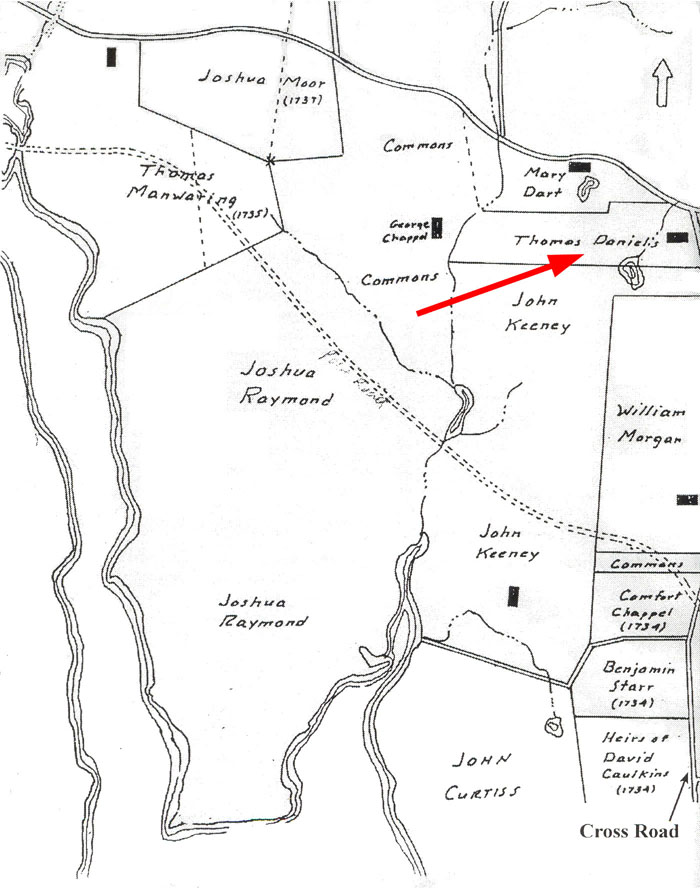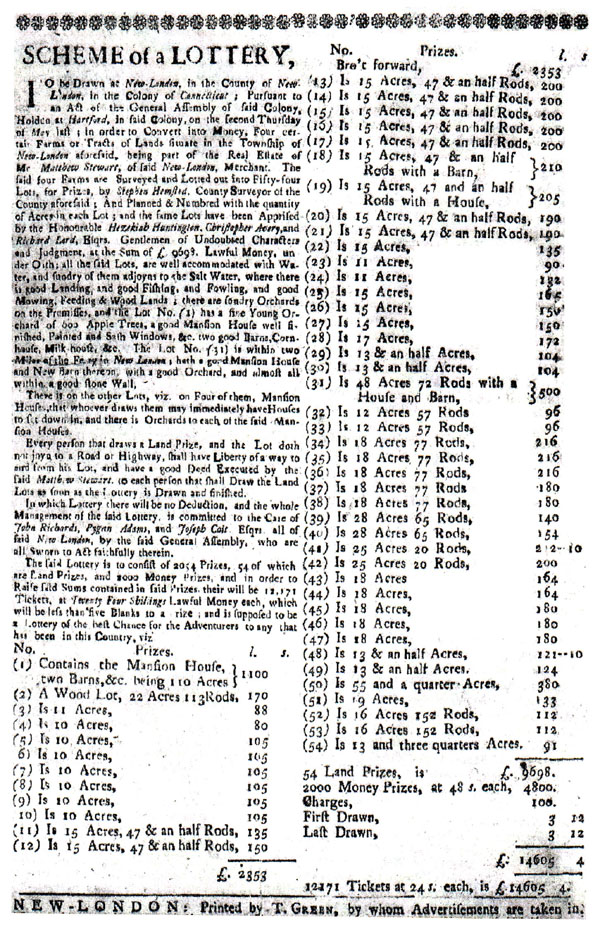
Reconstruction of the properties in the vicinity of the Daniels homestead, ca. 1730, by Robert Bucher. The house locations are conjectural. Click to enlarge.

Reconstruction of the properties in the vicinity of the Daniels homestead, ca. 1730, by Robert Bucher. The house locations are conjectural. Click to enlarge. |
Thomas Daniels (1690-1735) was a young man of 22 years when, early in 1712, he built a house on this property. We know that the house frame was up by May of that year because Joshua Hempstead, a local farmer, surveyor, and stonecutter, recorded working on the house's siding and roof in his diary. On July 2, 1712, Thomas Daniels married Hannah Keeney, who was then about 15 years old.
The land on which the newlyweds' new house stood did not actually belong to them at the time; it was owned by Hannah Daniels's father, John Keeney. The following year, 1713, Keeney sold the property, comprising some 20 acres of land, to Thomas Daniels for a purchase price of 20 pounds sterling. The Daniels homestead grew by 10 3/4 acres in 1716, when Thomas purchased an adjacent lot, and again in 1717, when he added another 9 1/2 acres. The resulting farm of 40 acres was small, even by Colonial standards, but certainly adequate to support a young family.
We know from the probate inventory of his possessions at the time of his death that Thomas Daniels, like most of his neighbors, operated a small, general-purpose farm. (Thomas Daniels died very suddenly in March 1735, reportedly from pleurisy, an infection of the lung's membranes; he was 46 years old). He had a variety of farming implements, including a hoe, plow, chains, and a cart. Livestock on the Daniels farm consisted of seven head of cattle of various ages, a horse and colt, ten sheep and eight lambs, and three hogs. These animals would have provided the Daniels family with milk, butter, wool, and meat and may also have generated a small surplus to be sold to others. One intriguing aspect of the Daniels farm was that at the time of Thomas's death there were six oxen. Since no farm of this size needed more than one team (two oxen) to plow and harrow the fields and haul the hay in, it appears that Daniels was raising some of these animals for beef. Waterford until 1801 was part of the Town of New London, the waterfront of which was home to a major Connecticut coastal port. Merchants in New London would have constituted a ready market for packed beef and other farm products, which they would send to the West Indies in exchange for sugar, molasses, and rum.
In addition to his farming equipment, Thomas Daniels owned a set of carpenter's tools, suggesting that he had other skills as well by which to support his family.
Following Thomas Daniels's death his children inherited the property, but they soon sold it to Matthew Stewart, a wealthy New London merchant, with the proviso that their mother, Hannah, be allowed her lifetime right to the property as a widow. On May 17, 1744 Hannah Daniels died. Her probate inventory listed only a few posssession, including wearing apparel, bedding, two spinning wheels, a few domesticated animals, and some cooking and serving utensils.

Advertisement for Matthew Stewart's lottery in the New London Gazette, 1767. Click to enlarge. |
In addition to his mercantile activities, Matthew Stewart had invested heavily in farmland in and around New London, but by the late 1750s he was facing bankruptcy because of heavy losses to French privateers during the Seven Years War. In order to pay off his debts, Stewart came up with a lottery "scheme". He hoped to sell over 12,000 tickets at 12 shillings each, with the prizes being 54 different lots of land, ranging in size from 11 to 55 acres. Houses and barns came with several of the lots, including the homestead he had bought from the Daniels heirs. The tickets sold slowly, however, and it was years before all of the property was disposed of and his debts resolved.
The archaeological data indicate that the Daniels house was occupied until the 1770s, but it is not known who resided there after Hannah Daniels's death in 1744. It may have been a tenant leasing the property from Matthew Stewart, someone who won it in the lottery (the records of which are incomplete), or even a squatter. Eventually, the former Daniels homestead ended up as part of the Gorton family's farmland. Maps dating from the middle of the 19th century show no house on the site. At some point, the house was removed and the cellar filled in and covered with earth. The Daniels Homestead site lay buried under a farm field for 200 years before its discovery in 2000 by archaeologists.